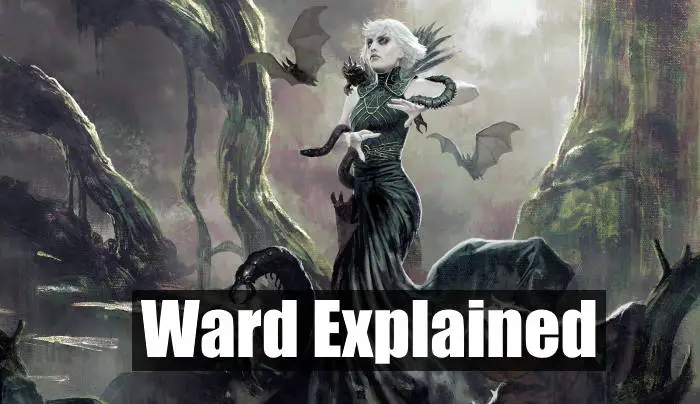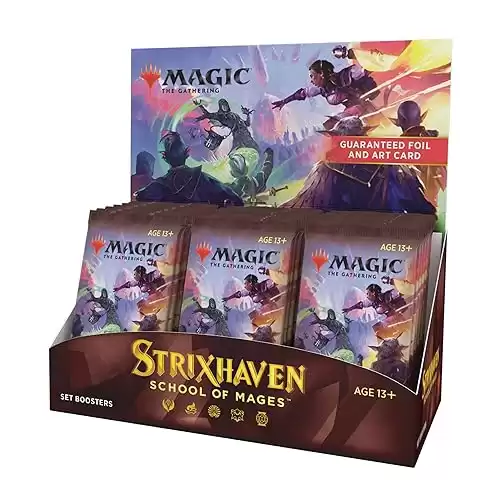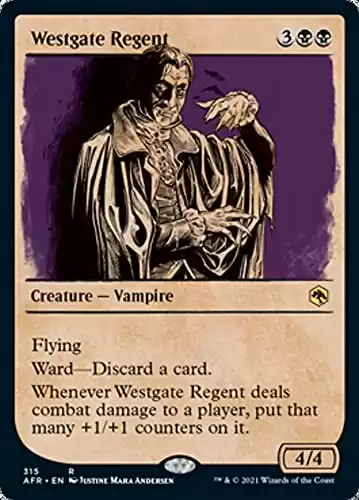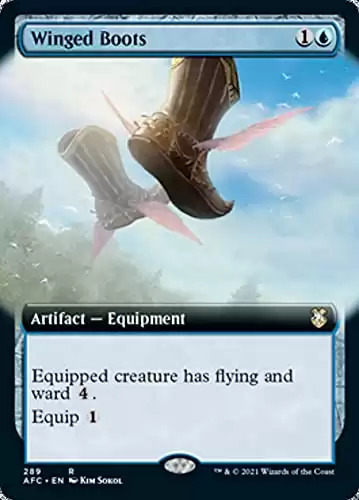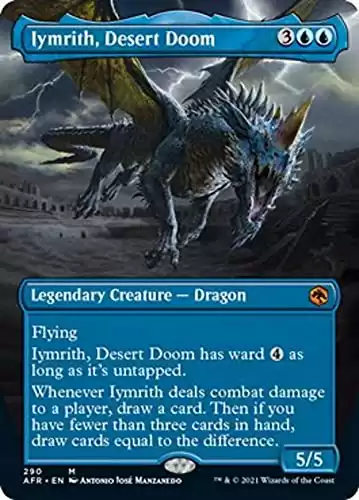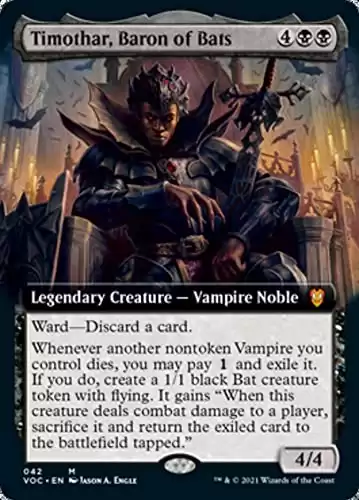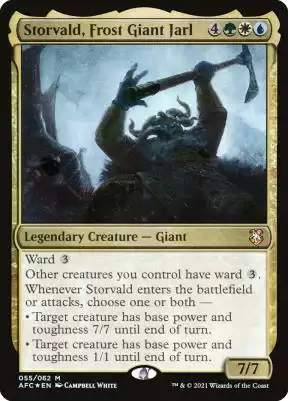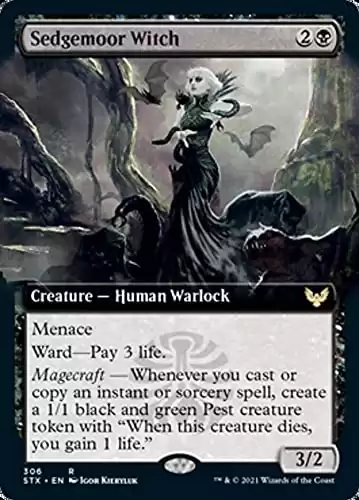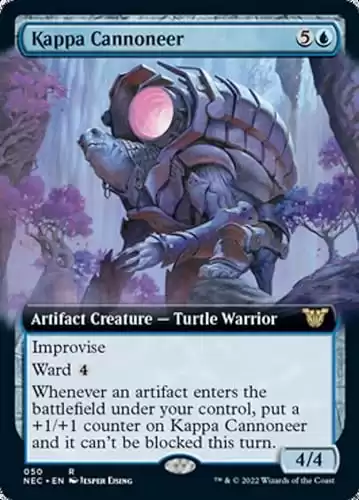Ward is a brand-new mechanic. When new mechanics come around, there is always a little bit of confusion as to what it is and how it works. In this article, I will uncover all of the mysteries behind one of magics’ newest mechanics, ward.
Ward is a mechanic in Magic: The Gathering that forces an opponent to pay mana whenever the permanent with ward is targeted by a spell or ability an opponent controls. If the cost is not paid, the opponent’s spell or ability will be countered.
While ward might seem like a more “watered-down” version of hexproof it is still powerful and unique. In this article we will talk about what ward is, how it is used, and why it can be so powerful.
What is Ward and How Does It Work?
Ward is a mechanic that was introduced in 2021 with the set Strixhaven: School of Mages. Ward is also one of MTG’s newest “Evergreen” words. The definition of an “Evergreen” word, is a keyword or key phrase that can be used in any set.
Besides just being an evergreen word, ward is a very interesting and new mechanic. This keyword is very powerful and is very similar to shroud or hexproof. Just as I explored dredge in my last article seen here, we will dive into and learn a little more about ward.
As of the date of writing this article, there are 42 cards that have the keyword ward. Below is the definition of what ward does.
702.21a Ward is a triggered ability. Ward [cost] means “Whenever this permanent becomes the target of a spell or ability an opponent controls, counter that spell or ability unless that player pays [cost].”
Magic: The Gathering Rule 702.21a
Why is Ward so Powerful?
Ward is such a powerful mechanic. Ward forces the opponent to pay an extra cost for their spell or ability to resolve. Otherwise, it will get countered. In most cases, ward forces the opponents to pay extra mana. This can be very disruptive and difficult to deal with for an opponent, as they most likely won’t be able to use their mana efficiently. This kind of disruption would mean that an opponent can play less cards per turn. This means that you should be able to out value them in the long run as well.
Does Ward Affect Board Wipes?
Ward does not affect
However, say a targeted removal spell is copied to apply to the whole entire battlefield. Kind of like how Zada, Hedron Grinder does. The person who has the copy of the spell would still have to pay the ward cost of any creature with ward that they are targeting.
Does Ward Work Against Deathtouch?
Ward unfortunately does not work against deathtouch. Deathtouch does not target a creature and therefore, ward can not apply.
To clarify a little better, let me give you this example. If I attack with my Westgate Regent and my opponent chooses to block with their Baleful Strix both creatures would die. Baleful Strix would die due to Westgate Regent’s power being greater than Baleful Strix’s toughness. Westgate would die due to Baleful Strix’s deathtouch.
Does Ward Work Against Counters?
The answer to this question is no. Ward does not work against counterspells. When Ward is on a creature, it will only work while the creature is on the battlefield. This is why a creature with ward can be countered by a counterspell while on the stack.
Can Ward Stack?
In short, the answer is yes. Each instance of ward that a creature has, has to be paid for separately. For example if you have Westgate Regent and Storvald, Frost Giant Jarl and Westgate Regent is being targeted by an opponent both costs would have to be paid. Storvald gives Westgate Regent Ward 3 and Westgate already has Ward – discard a card. That means that your opponent would have to pay for Westgate’s ward cost by discarding a card and pay for Storvald’s by paying 3 mana.
Top 7 Creatures With Ward
While there are a bunch of cards with ward – below are the top 7 cards so far.
7. Westgate Regent
Westgate Regent is acard with a powerful ward cost. No matter the strength of the rest of the card, forcing your opponent to 2 for 1 themselves to get rid of a threat is so important. If you are able to consistently force your opponent to 2 for 1 themselves, you will most likely win the game. This is called, out valuing your opponent. Westgate Regent‘s ward cost of “Discard a card” causes this situation exactly.
- Forces the opponent to 2 for 1 themselves to remove it
- Gets bigger if it hits
- There are usually better cards that would fit into the 5 mana slot in a deck
This card does have an evasion tactic, flying, and an ability to make it get more counters as it deals more damage. That means that over time, your opponents will need to remove this card more and more or risk losing the game to it.
While this card could perform great in a black deck, in most decks there are better options for a 5-mana spell. That being said, I would still try this card out in decks and see how it performs. In any deck that could synergize with +1+1 counters, I would include this card.
6. Winged Boots
Winged Boots reminds me so much of Swiftfoot Boots. They are both two mana artifact equipment that cost 2 to cast and 1 to equip. Both of the cards give the equipped to create two different keywords. Winged Boots gives flying and ward 4. Swiftfoot Boots give hexproof and haste.
- Synergizes with flying
- Swiftfoot boots are generally better
Overall, Swiftfoot Boots is better but there will be some decks that would rather run Winged Boots. Some decks might be able to take advantage of the flying that Winged Boots gives the creature. While hexproof is a better keyword than ward, ward 4 is still a lot of mana an opponent will have to pay to try to kill your flying creature.
5. Iymrith, Desert Doom
Iymrith, Desert Doom is a very fun card with ward. Some people like to run him as a commander. For more on that, see this article here.
- Has possibility to draw 3 cards
- Sometimes has ward 4
- Could draw 0 cards
- If you want to try to draw cards, in most cases it will lose ward 4.
Iymrith has ward 4 as long as it is untapped. Which is great! This helps Iymrith survive after you cast it, until it is your turn again. When Iymrith deals combat damage, you draw until you have 3 total cards in hand. While this isn’t the best, it certainly isn’t the worst. Some extra draw power is certainly welcomed even if it is conditional. The good part about this is that when you have less than 3 cards in hand, you really need to draw cards. So at least this cards gets to help at that point.
A great strategy to using this card would be to find a way to give it vigilance or a way to untap it at instant speed. This would let you get the best of both worlds.
4. Timothar, Baron of Bats
Timothar, Baron of Bats is a very strong card with ward. This cards ward cost is “Discard a card”. This means that if your opponent wants to target Timothar to remove it, they have to do it in a card disadvantageous way. What that means is that the opponent needs to use 2 cards to get rid of your 1 card. This makes this card instantly so much better than many other cards with ward
- Forces the opponent to 2 for 1 themselves to remove it
- Unique ability that gives recursion to a tribal deck that doesn't naturally have much recursion
- High mana cost in the decks that would take advantage of it the most
Another reason why Timothar is so strong is that it provides some unique kind of recursion in a vampire tribal deck. Timothar’s second ability reads, “Whenever another nontoken Vampire you control dies, you may pay 1 and exile it. If you do, create a 1/1 black bat creature token with flying. It gains, “When this creature deals combat damage to a player, sacrifice it and return the exiled card to the battlefield tapped.” Vampires generally don’t have any built in recursion like Timothar does, which makes it a unique addition in a vampire tribal deck.
While Timothar, Baron of Bats is a unique addition to a vampire tribal deck, that is where some of this cards downsides start to shine through. Vampires generally want to be a very aggressive deck and a 6 mana vampire that comes in an doesn’t help win the game immediately can be tough to include in the deck. While this card will help with the longevity of your vampire tribal deck, I’m not sure if I would include this card over Bloodlord of Vaasgoth. However, in any slower vampire tribal deck, I think this is an auto include.
3. Storvald, Frost Giant Jarl
Storvald, Frost Giant Jarl is a 7 mana 7/7 with ward 3. This card also gives ward 3 to other creatures you control. This is such a powerful ability to give because now everything on you side of the field is much harder to remove.
- Makes other creatures tough to remove
- Can make combat very interesting
- Tough to remove
- High mana value
Storvald also has the ability to change the base power and toughness of a creature to 1/1 or 7/7. This can make for some interesting combat and some tricky interactions. This triggers once it enters the battlefield and when it attacks. This means that you can get a benefit to Storvald on the turn that it is cast. If you can give this card haste, you would get it to trigger two times in a turn, which is pretty powerful.
The reason Storvald is where it is on this is is due to his high mana cost and susceptibility to being countered. It would feel pretty bad to pay 7 mana for him just to get countered.
2. Sedgemoor Witch
Sedgemoor Witch is a fantastic card with ward. This card was originally printed in Strixhaven and has been tried out in many different formats. Sedgemoor Witch is a 3/2 with menace, magecraft, and ward- pay 3 life. The magecraft ability on this card is amazing. Each time you cast an instant or sorcery spell, crate a pest token. That means that as long as you cast a spell, you generate card advantage with this card.
- Low mana cost
- Generates card advantage
Also, to have this threat removed, the opponent will have to pay 3 life just to target it. While this might not be as difficult to do in commander, it can be a win condition in some of the other constructed formats that start with 20 life. All in all, this card is a card advantage engine for most decks that would play it.
1. Kappa Cannoneer
Kappa Cannoneer is the best card with so far in MTG. On the surface, this card seems to cost a lot. This card is a 6 mana spell after all. Due to Kappa Cannoneer‘s Improvise ability and as long as you have other artifacts, those other artifacts can tap to help pay its mana cost.
- Easy to cast because of Improvise
- Very synergistic and a huge threat in an artifact deck
- Very difficult to remove and in the color with the most counter spells
- Price of the card is quickly rising
This card has another ability involving artifacts. Its ability is, “Whenever an artifact enters the battlefield under your control, put a +1/+1 counter on Kappa Cannoneer and it can’t be blocked this turn.” This ability makes Kappa Cannoneer so difficult to deal with. In an artifact deck, this card will get larger and larger and be unblockable for most of the time.
The last ability on this card is of course, ward 4. As discussed in this article ward is a very powerful and difficult-to-deal-with ability. Because this keyword is on Kappa Cannoneer this makes him a very difficult to deal with threat. Another benefit comes when an opponent casts a removal spell on this card and has to tap a bunch of extra mana. Because Kappa Cannoneer is a blue card, the likely hood of you having a counter spell to save this card is high. Then your opponent will be out of a removal spell that they spent so much extra mana to cast.
Clean Up Step
After reading this article, I have hopefully uncovered the mystery around this new keyword. Ward is a very fun mechanic in MTG and now you know how it works, why it is so powerful, and some of the best cards that have this keyword.
